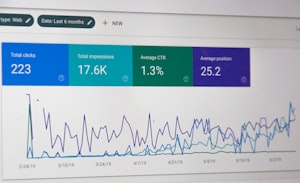Let's talk about video analytics!
Are you not getting the traction you were looking for with your videos? No onsite clicks, no actions, minimal follow-ups? But hey, your video has more than a thousand views, right?
Sorry to disappoint you, just counting views on your videos is like counting stars (Keep on reading to find out why).
You will never know whether your video marketing strategy is working or not, based on just views. There are a plethora of metrics behind the veil of views for every video.
From the moment a video is opened to the bounce, the data collected by video platforms is incredibly huge.
Let’s have a look at some of the key metrics and video analytics that you must track to accurately judge the performance of your videos.
Key Video Metrics to Measure
View Count

Well, regardless of it being kind of useless on its own, view count adds a lot of value to analytics when combined with other metrics listed down below.
View count deserves the honorable number one spot on this blog post, simply because of being probably the oldest video metric out there. And just like a wise old man, view count has a lot of wisdom to offer, with the right context and reception. Otherwise, it just seems grumpy.
Why I am constantly bashing view count is simply because it is a dubious metric. A hundred views that would otherwise mean nothing, make a world of difference even if 10 out of those 100 were hot leads, fit your ICP (Ideal Customer Profile) and end up converting after viewing the video in question. And maybe, 100 out of 100 end up converting.
But just like any other pipe dream, perfect proportions of view count and conversion is just a dream. Even the 10 out of 100 is somewhat of a pipe dream.
Even with millions of views on a video, some brands have received only a minuscule amount of conversions.
The views you get are not filtered based on your target audience, or any other such segregation. These are just views.
But if they are segregated using other metrics like demographic, age group, sex, etc., views can be life-changing for the growth of a business through video marketing.
Click-Through Rate

There are multiple ways to plug or host your videos. Your viewer could directly view the video through the page the video is hosted on or the video could be viewed through a page it is embedded on or through an email.
With “click-through-rate” we look at videos opened through sources other than the actual page the video is hosted on. This could be a click-through-rate on the email that mentions a “video” in the subject or a landing page that incites action and redirects the user to a video.
Click-through-rate helps you determine the value videos add to business communications as a subject matter. This will help you analyze whether or not your audience cares about your videos or not.
A low click-through-rate is indicative of multiple things. The more likely one being that your thumbnail or title is not compelling enough for the user.
See, a thumbnail is naturally the most attractive and eye-catching window a viewer has into your video. The title has relevance, but the thumbnail has the power.
Using preview GIFs in thumbnails is a great way to attract clicks on your videos or simply well-edited GIFs are good too.
Although click-baiting viewers depletes your brand value in some sense, clickbait thumbnails do work.
It all depends on your audience. Same goes for the title. In the context of click-through-rate, the title may not be SEO friendly, but just attractive or compelling enough to incite a click.
Call-to-Action Click-Through Rate

Much like click-through rate, call-to-action click-through rate is about the actions incited by a video.
If you are following the basics of video marketing well enough, you might have a set of goals you are working toward with your videos.
For most businesses, videos aren’t created just for the sake of it. They are created to incite some action. This is why brands add CTAs to their videos.
Regardless of whether or not you added CTAs to your video, CTA click-through-rate looks at the action a viewer took after watching a video. Most likely there is an actionable link somewhere around the video, if not directly in it.
Even if you are generating a search on Google post-viewing a video, that would add to your CTA click-through-rate.
Curiosity does not kill the cat in the case of video marketing, it feeds the cat and many others. As long as you make compelling content that gets people going, you’re winning. Granted, this could be a negative action. But hey, ‘no such thing as bad press’.
However, if you are not generating much action. It’s time to take a step back and revisit your script.
Either your content is boring, or it is not at par with your competitor’s value proposition. You expand on the reason why further using other user impressions like bounce time.
Return on Investment (ROI)

Arguably, one of the most important metrics of digital marketing is ROI or Return on Investment. A good ROI is the answer to all existentialism you will have during filming a tricky video: “Why am I doing this” “Why am I here”.
The ROI will tell you why you are here, and whether or not you should be creating videos or the type of videos that you are creating.
Simply put, ROI is the growth you receive in terms of direct conversions and money generated through it divided by the cost of video production and publishing.
This will give you an important number, and the higher it is, the happier you will be while filming.
If you are splurging on set design, professional editors, and a huge team of actors; you should look at ROI for every video. And if you are not getting a big number, it’s time to tone it down a notch.
You can record good looking professional videos for much less than you think. Get the free screen recorder by StoryXpress.
Additionally, the ROI helps you create a better video marketing strategy moving forward. If your ROI is good, you can expand your video production because clearly, your audience is liking your content.
This leads us to another type of ROI that is useful for growth. That is ROAS or Return on Ad Spend.
Creating video ads adds another layer of budget to video production, i.e. ads. If you are creating videos for ads and not getting anywhere, that would count as a low ROAS. This means time to publish your videos regularly.
The ROAS will help you understand how users are reacting to your video ads.
If you are driving more sales with ads, then go all guns blazing granted your ROAS is high.
If you are not running ads as of now but would want to sometime in the future, you can still calculate an estimated amount using tools like this.
Watch Time

This is our favorite metric here at StoryXpress. Watch time is simply the amount of video duration viewed by the prospect (or viewer).
Unlike video count, which takes every click and play on the video as an increment, watch time specifies the volume of watching through time.
Watch time is key to determine user attention and retention. The longer a video is watched, the more attention it receives. And that’s what a marketer wants.
If you grab the attention, you grab the sale. If your watch time is less, you need to add engaging elements to your video and spice things up a little.
Watch time is supplemented by other metrics like bounce time, which of course indicates the timestamp at which the user decided to bounce.
You can further calculate the average bounce time to determine the exact timestamp most of the viewers decided to bounce. This further enables you with more metrics like watch rate (watch time divided by the total duration of a video).
The above is in the context of individual watch time. You can take watch time up a notch by including overall watch time.
Overall watch time on a video determines the success of a video in terms of engagement thoroughly. With this, you can determine the value of each view.
It lets you calculate the average watch time (total watch time divided by view count) which is exactly what you need to create more engaging content. If your average watch rate is low, then hands down you need better videos.
If it is average, and the ROI is good enough, then maybe you need to take another look at the platform you are publishing your videos on.
Chances are, you are getting views from an uninterested audience along with your target audience.
Lead Generation

When you start publishing videos on public platforms, and pages; you open yourself up to a brand new audience. And if your videos are good enough, you invariably end up generating leads.
Videos are an extremely influential medium, and if you are collaborating with other creators, experts, or businesses for videos, there might be a little lead exchange going on.
You can track this with a very important metric with the net new leads you generate for every video. You will see a lot of these for how-to content, or expert panel webinars.
If you see peculiar growth in leads for a type of video hosted on a particular platform, it’s time to produce more content specific to or related to that.
Further, a lot of contribution for lead generation through videos comes from the platform. So, keep in mind to publish more content on that or a similar type of platform.
Social Media Shares

Speaking of platforms, how can we miss the most important platform for millennials and Gen Z.
Social media is the reason why videos are booming the way they are.
Businesses are constantly upgrading their social media strategies. Simply because on social media whatever works is so unpredictable, that it’s best to experiment.
You need some guiding feedback when you begin experimenting.
That’s why social media metrics are extremely important for videos. Because your prospects get vocal here. For the right kind of content, not only are your prospects willing to reply to your video but possibly share them.
Majority of the content shared on social media is in the form of videos. And the metrics come directly at the hand of the viewer.
In terms of actions observed, like ‘like’, shares, comments, direction message interaction.
Social media will never shy away from telling you exactly what lacks in your video. And neither will the social media metrics.
Which Is the Best Metric to Measure the Value of Video?
Undoubtedly the best metric to measure the value of videos today is the watch time.

Nobody has the patience to sit through long testimonial videos, but if you are still hitting a good enough watch time; you are doing something right.
Moreover, watch time is an umbrella metric that is indicative of all other metrics. Simply because nothing beats the engagement value of a video.
If a viewer is willingly watching a long video, it is because they are interested and their view counts. Watch time tells you the health of your video content.
View count represents your reach, click-through represents the appearance, watch time digs deep in to represent the quality of your video.
Sure, someone will click on a clickbait thumbnail but whether they sat through the entire video or not will be determined by the watch rate.
Regardless, a high watch rate with a lesser volume of view count is better than a higher view count with a less watch rate.
A higher watch rate means room to incite action is increased, therefore increasing the chances of conversion. Therefore, higher is the ROI.
The idea is to focus on creating better, high-quality content for your viewers and in turn, increase the watch time, further increasing conversions.
These metrics are extremely helpful to keep yourself on an upward graph of growth and ROI through video marketing.
With ever-changing trends, it is hard to figure out what you are doing wrong and way better than empty suggestions are the numbers that never lie.
Hope you will use these metrics to create better video content for your audience. You can install the StoryXpress Screen Recorder for powerful analytics that will guide you to create buzz online.


 Free Screen Recorder for Chrome
Free Screen Recorder for Chrome













